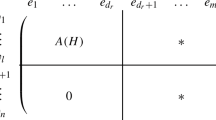Abstract
The relative generalized Hamming weight (RGHW) of a linear code C and a subcode C 1 is an extension of generalized Hamming weight. The concept was firstly used to protect messages from an adversary in the wiretap channel of type II with illegitimate parties. It was also applied to the wiretap network II for secrecy control of network coding and to trellis-based decoding algorithms for complexity estimation. For RGHW, bounds and code constructions are two related issues. Upper bounds on RGHW show the possible optimality for the applications, and code constructions meeting upper bounds are for designing optimal schemes. In this article, we show indirect and direct code constructions for known upper bounds on RGHW. When upper bounds are not tight or constructions are hard to find, we provide two asymptotically equivalent existence bounds about good code pairs for designing suboptimal schemes. Particularly, most code pairs (C, C 1) are good when the length n of C is sufficiently large, the dimension k of C is proportional to n and other parameters are fixed. Moreover, the first existence bound yields an implicit lower bound on RGHW, and the asymptotic form of this existence bound generalizes the usual asymptotic Gilbert–Varshamov bound.
Similar content being viewed by others
References
Chor B., Goldreich O., Håstad J., Friedmann J., Rudich S., Smolensky R.: The bit extraction problem of t-resilient functions. In: 26th Annual IEEE Symposium on Foundations of Computer Science, Portland, pp. 397–407 (1985).
Cohen G., Litsyn S., Zémor G.: Upper bounds on generalized distances. IEEE Trans. Inf. Theory 40(6), 2090–2092 (1994)
Encheva S., Kløve T.: Codes satisfying the chain condition. IEEE Trans. Inf. Theory 40(1), 175–180 (1994)
Fan Y., Liu H.: Equidistant linear codes and maximal projective codes. J. China Inst. Commun. 6(22), 48–52 (2001)
Forney G.D.: Dimension/length profiles and trellis complexity of linear block codes. IEEE Trans. Inf. Theory 40(6), 1741–1752 (1994)
Helleseth T., Kløve T., Levenshtein V.I., Ytrehus Ø.: Bounds on the minimum support weights. IEEE Trans. Inf. Theory 41(2), 432–440 (1995)
Helleseth T., Kløve T., Mykkeltveit J.: The weight distribution of irreducible cyclic codes with block lengths n 1((q l−1)/N). Discret. Math. 18, 179–211 (1977)
Helleseth T., Kløve T., Ytrehus Ø.: Generalized Hamming weights of linear codes. IEEE Trans. Inf. Theory 38(3), 133–1140 (1992)
Huffman W.C., Pless V.: Fundamentals of Error-Correcting Codes. Cambridge University Press, Cambridge (2003)
Hughes D.R., Piper F.C.: Design Theory. Cambridge University Press, Cambridge (1998)
Kasami T., Takata T., Fujiwara T., Lin S.: On the optimum bit orders with respect to the state complexity of trellis diagrams for binary linear codes. IEEE Trans. Inf. Theory 39(1), 242–243 (1993)
Kløve T.: The worst case propability of undetected error for linear codes on the local binomial channels. IEEE Trans. Inf. Theory 42(1), 172–196 (1996)
Komura T., Oka M., Fujiwara T., Onoye T., Kasami T., Lin S.: VLSI architecture of a recursive maximum-likelihood decoding algorithm for a (64,35) subcode of the (64,42) Reed–Muller code. In: International Symposium on Information Theory and Its Applications, Victoria, pp. 396–407 (1996).
Lin S., Kasami T., Fujiwara T., Fossorier M.: Trellises and Trellis-based Decoding Algorithms for Linear Block Codes. Kluwer Academic Press, Boston (1998)
Lin S., Uehara G.T., Nakamura E., Chu W.P.: Circuit design approaches for implementation of a subtrellis IC for a Reed–Muller subcode. NASA Tech. Rep. 96–001 (1996).
Liu Z., Chen W., Luo Y.: The relative generalized Hamming weight of linear q-ary codes and their subcodes. Des. Codes Cryptogr. 48, 111–123 (2008)
Luo Y., Fu F., Mitrpant C., Han Vinck A.J.: Relative MDS pairs. Unpublished manuscript.
Luo Y., Mitrpant C., Han Vinck A.J., Chen K.F.: Some new characters on the wire-tap channel of type II. IEEE Trans. Inf. Theory 51(3), 1222–1229 (2005)
MacWilliams F.J., Sloane N.J.A.: The Theory of Error-Correcting Codes. North-Holland, Amsterdam (1988)
Ozarow L.H., Wyner A.D.: Wire-tap channel II. Bell Labs Tech. J. 63(10), 2135–2157 (1984)
Tsfasman M.A., Vlǎdut S.G.: Geometric approach to higher weights. IEEE Trans. Inf. Theory 41(6), 1564–1588 (1995)
Wei V.K.: Generalized Hamming weights for linear codes. IEEE Trans. Inf. Theory 37(5), 1412–1418 (1991)
Wolf J.K.: Efficient maximum likelihood decoding of linear block codes. IEEE Trans. Inf. Theory, IT- 24(1), 76–80 (1978)
Zhang Z.: Wiretap networks II with partial information leakage. In: 4th International Conference on Communications and Networking in China, Xi’an, pp. 1–5 (2009).
Zhang Z., Zhuang B.: An application of the relative network generalized Hamming weight to erroneous wiretap networks. In: 2009 IEEE Information Theory Workshop, Taormina, pp. 70–74 (2009).
Zhuang Z., Luo Y., Dai B., Han Vinck A.J.: Relative dimension/length profile and its applications. Des. Codes Cryptogr. (in manuscript).
Zhuang Z., Luo Y., Han Vinck A.J.: Bounds on relative generalized Hamming weight. Inf. Sci. (in manuscript).
Zhuang Z., Luo Y., Han Vinck A.J., Dai B.: Some new bounds on relative generalized Hamming weight. In: 13th International Conference on Communication Technology, Jinan, pp. 971–974 (2011).
Author information
Authors and Affiliations
Corresponding author
Additional information
Communicated by I. Shparlinski.
Rights and permissions
About this article
Cite this article
Zhuang, Z., Luo, Y. & Dai, B. Code constructions and existence bounds for relative generalized Hamming weight. Des. Codes Cryptogr. 69, 275–297 (2013). https://doi.org/10.1007/s10623-012-9657-7
Received:
Revised:
Accepted:
Published:
Issue Date:
DOI: https://doi.org/10.1007/s10623-012-9657-7
Keywords
- Existence bound
- Generalized Hamming weight
- Relative generalized Hamming weight
- Trellis complexity
- Wiretap channel of type II
- Wiretap network II




